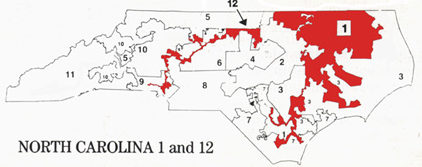
Gerrymandering and Race.
Shaw v. Reno (1993) was an extremely divisive 5-4 Supreme Court case which cast a light on race, the Equal Protection Clause of the 14th Amendment, majority-minority districts and racial gerrymandering. The case involves the creation of two majority-minority congressional districts in order to ensure compliance with the recently updated Voting Rights Act of 1964. The districts were oddly shaped, but did allow for two minority-majority districts. A group of white voters sued claiming that a racial gerrymander deprived them of their 14th Amendment rights which states, “No state shall…nor deny to any person within its jurisdiction the equal protection of the laws.” The white voters said that while race could be used as a factor, it cannot be the only factor used.
Based on your reading of this, understanding of the Constitution, and your own political beliefs, complete the questions that follow.
Questions for Completion:
1. What are the advantages and disadvantages of majority-minority districts?
2. Is gerrymandering a political question, outside the scope of the Constitution?
3. To what extent does an oddly shaped district designed to increase the number of minority-majority districts constitute an Equal Protection Clause violation?
4. How do you think the Supreme Court will rule? Why?